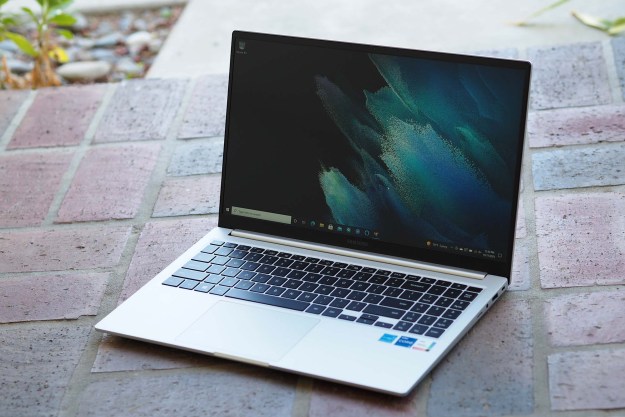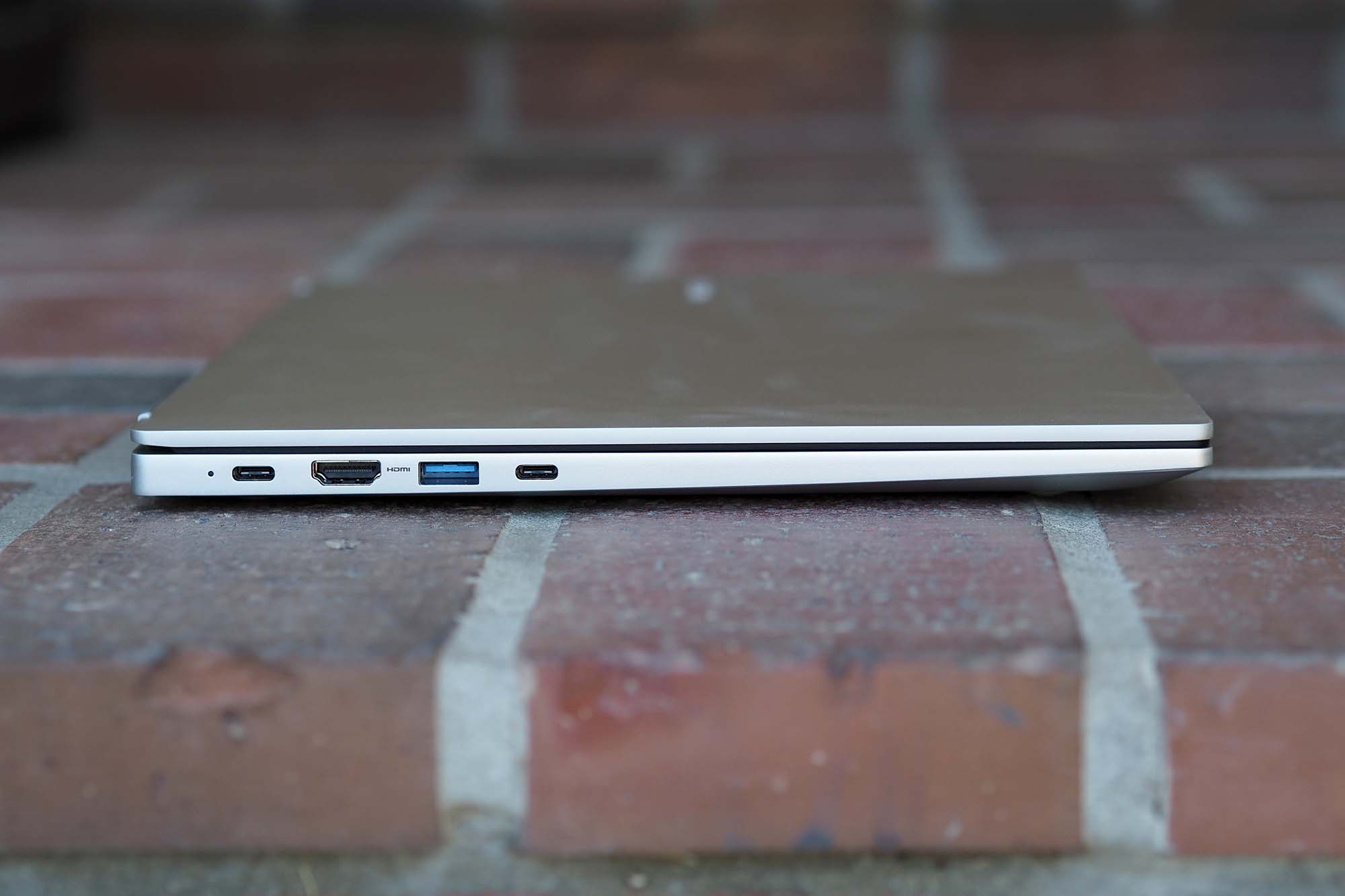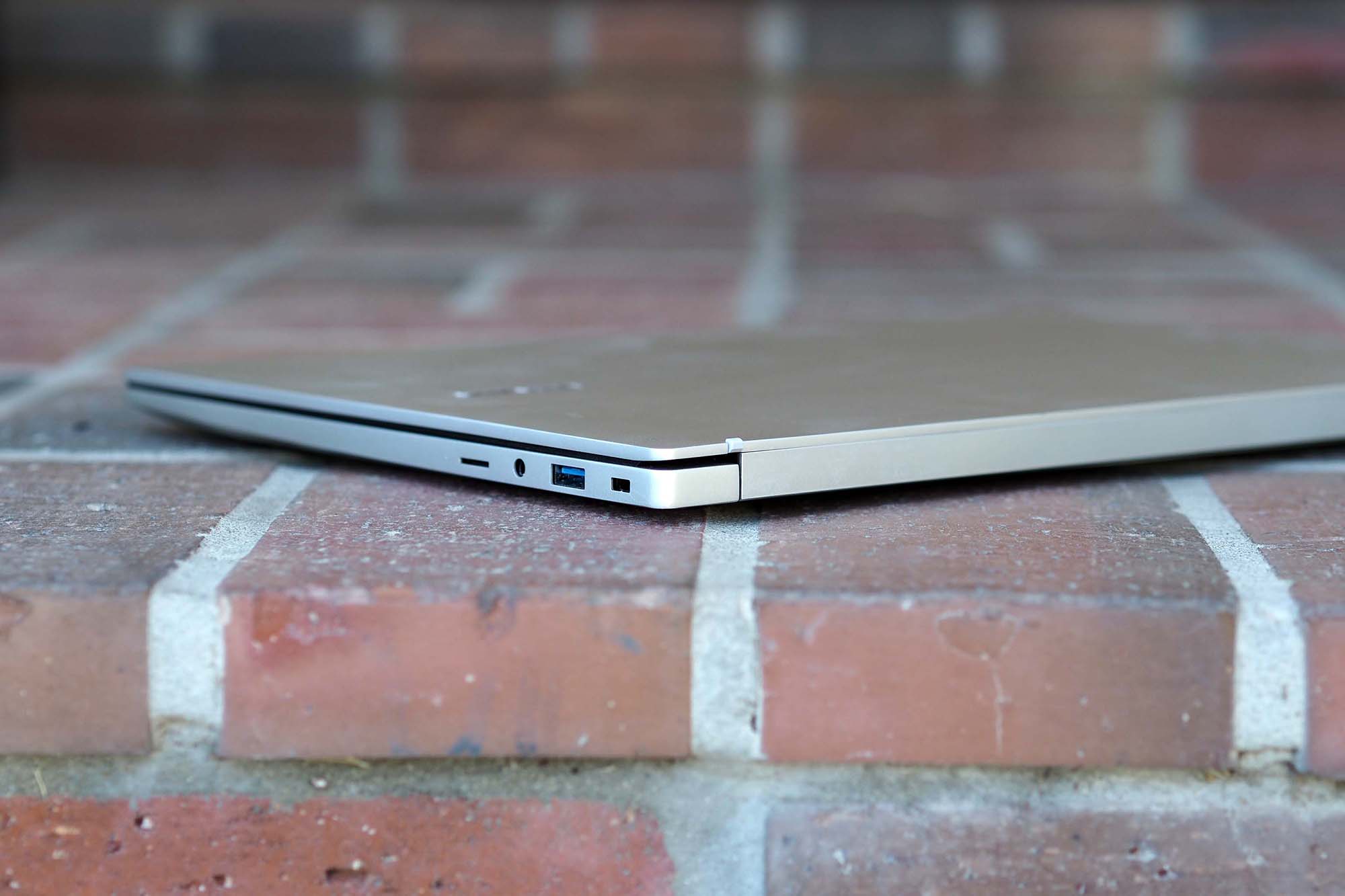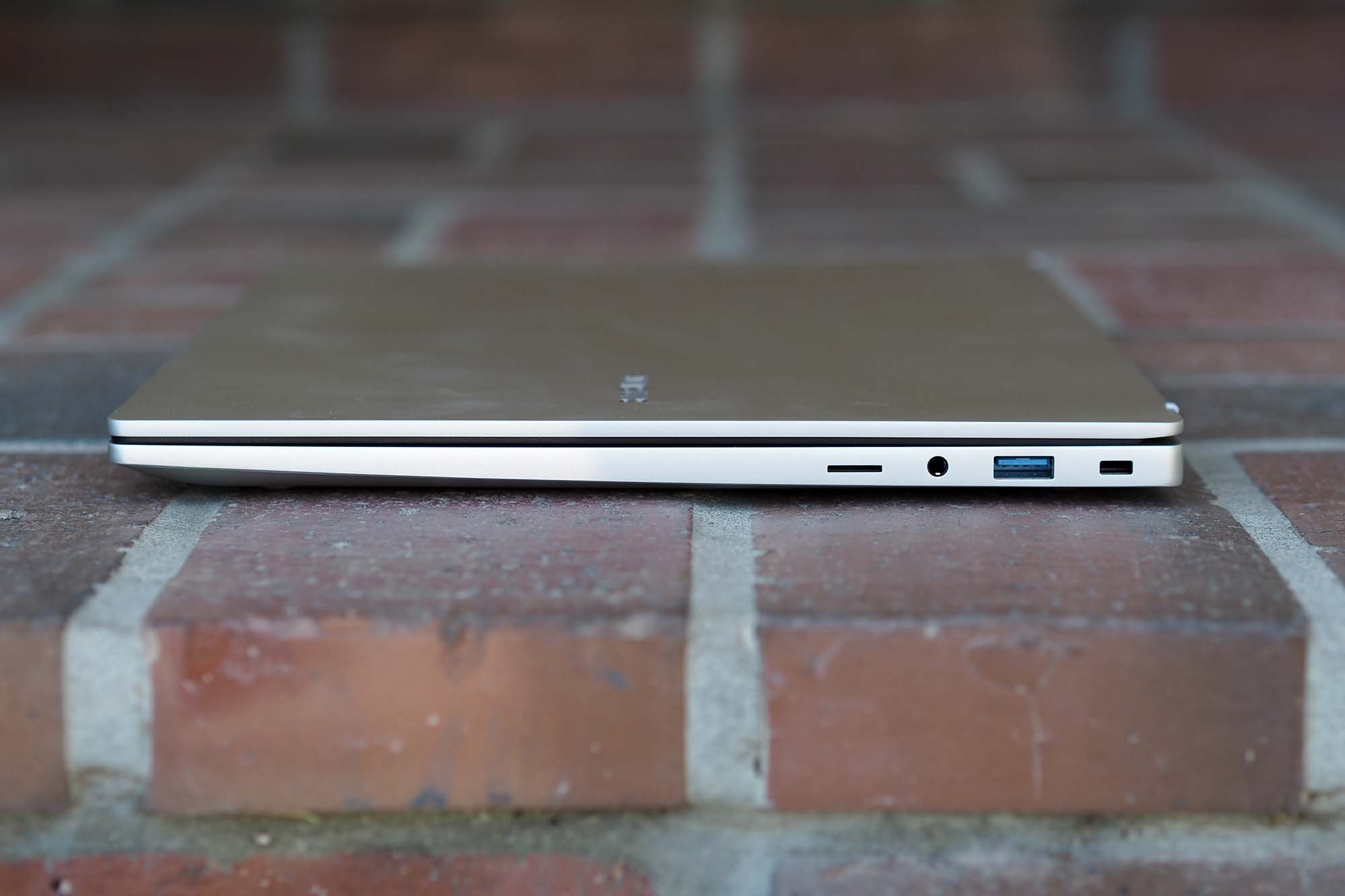
“The Samsung Galaxy Book for business has good enough productivity performance and battery life, but its display is subpar and it lacks any compelling features.”
- Thin and light
- Excellent keyboard and touchpad
- Solid productivity performance
- Good productivity battery life
- Disappointing display quality
- Too much give in the lid and chassis
- No meaningful business features
Samsung is more committed than ever to making a laptop that lives up to the pedigree of the Galaxy brand.
The Galaxy Book Pro came close, though, with its ultrathin chassis and vivid OLED screen. But can a cheaper, more basic version of that laptop have the same effect?
The Samsung Galaxy Book I tested was technically the “for business” model, though it’s nearly identical to the consumer model on the hardware side of things. The laptop features an Intel Core i5-1135G7 processor, 15-inch 1080p screen, and costs $900.
That sits in the middle of the pack considering the price, features, and design. Unfortunately, the price isn’t low enough to justify this many compromises, especially with so many other great options
Design

The Galaxy Book is constructed of aluminum, which usually results in solid build quality. However, Samsung must have used thin aluminum to cut weight, because the lid bends more than I like and there’s quite a bit of keyboard flex. The Acer Aspire 5, a budget-oriented 15-inch machine that you can buy similarly configured for less than $500, had slightly better rigidity in the keyboard deck and chassis, although its lid was also a bit bendable.
The HP Envy x360 15 is around the same price as the Galaxy Book and is much more solid. If you jump up in price, of course, then you’ll get much better build quality, but I think the Galaxy Book should feel more solid at its retail price of $900. An example of a much more expensive laptop that demonstrates the same lack of rigidity as the Galaxy Book is the LG Gram 16 that’s constructed of magnesium, but it’s also just 2.62 pounds — in this case, you’re trading solidity for extremely light weight.
At 3.42 pounds, the Galaxy Book is also relatively lightweight for a 15-inch machine, with the Acer Aspire 5 coming in close at 3.64 pounds. The Acer benefits from some plastic components, however. More robust laptops like the Envy x360 15 and Dell XPS 15 tend to weigh four pounds or more. The Galaxy Book is 0.61 inches thick, slimmer than the Aspire 5 at 0.70 inches, the Envy x360 15 at 0.72 inches, and the XPS 15 at 0.71 inches.

All in all, one of the Galaxy Book’s greatest strengths is its thin and light nature, which makes me a little more forgiving of the laptop’s bending and flexing. The Galaxy Book’s bezels around the old-school 16:9 display aren’t that tiny, though, particularly along the top and bottom, and so it’s still a full-size 15-inch laptop.
Aesthetically, the Galaxy Book is a rather mundane silver color that’s reminiscent of so many other
One note about software. Samsung includes a ton of extra applications in addition to the usual support utilities. They include Samsung Flow, a pen app that has no use on the Galaxy Book, Samsung Gallery, Samsung Studio Plue, Samsung TV Plus, etc. Some of these apps might be useful, but for anyone who doesn’t want extra apps installed on their
Connectivity is decent. Two USB-C ports, a full-size HDMI port, and a USB-A port line the left-hand side, while the right-hand side is populated with another USB-A port, a microSD card reader, and a 3.5mm audio jack. There’s no Thunderbolt 4 support, which we’ve seen on
Performance

You can buy the Galaxy Book with either a Core i5-1135G7 or a Core i7-1165G7. My review unit was equipped with the Core i5, and it performed well given the CPU.
Across all our benchmarks, the Galaxy Book was at or near the top compared to a handful of other Core i5-1135G7-equipped
In the PCMark 10 Complete benchmark, the Galaxy Book once again took the top spot with a score of 4735. It also did well in the Essentials, Productivity, and Content Creation portions of the benchmark.
Overall, the Galaxy Book was a solid productivity performer, able to keep up with heavy workflows. Its performance is another area where the Galaxy Book earned its $900 price.
| Geekbench (single/multi) | Handbrake (seconds) |
Cinebench R23 (single/multi) | PCMark 10 | 3DMark Time Spy | |
| Samsung Galaxy Book (Core i5-1135G7) | 1401 / 5221 | 175 | 1361 / 5391 | 4735 | 1584 |
| Lenovo IdeaPad Flex 5i 14 (Core i5-1135G7) |
1397 /4301 | 213 | 1325 / 4411 | 4550 | 1026 |
| Lenovo ThinkBook 13s Gen 2 (Core i5-1135G7) |
1406 / 5379 | 178 | 1357 / 5502 | 4668 | 1511 |
| HP Envy 14 (Core i5-1135G7) | 1549 / 5431 | 204 | 1399 / 4585 | n/a | 1380 |
| Acer Aspire 5 2021 (Core i3-1115G4) | 1215 / 2544 | 300 | 1274 / 3128 | 3752 | 652 |
The Galaxy Book did well in the 3DMark Time Spy test at 1584, leading our comparison group. That’s not a great score for a gaming laptop, however. We usually use Fortnite to test thin and light
Display

At $900, one should expect a decent display. Given that Samsung is known for making excellent displays, this is doubly true for the Galaxy Book. Subjectively, I found the 15.6-inch Full HD (1920 x 1080) display to be bright enough for all the places where I usually work, but I wasn’t impressed with the apparent contrast or colors. In particular, I found black text on white backgrounds to be a little on the grey side.
My colorimeter confirmed my suspicions. The Galaxy Book’s brightness was fine at 326 nits, exceeding our 300-nit threshold. Things went downhill from there, though. The display’s colors were surprisingly narrow at just 48% of AdobeRGB and 64% of sRGB, and they weren’t particularly accurate with a DeltaE of 2.41 (1.0 or less is considered excellent). This is a huge disappointment, especially at this price.
Worse yet, contrast came in at just 700:1, well under our preferred 1,000:1. It’s not uncommon to see these kinds of results in
This is a laptop that’s intended for casual business users, and they don’t require the wide and accurate colors demanded by creators. But they do expect something closer to the industry average for the class of machine, and this display just doesn’t live up to that standard. I was surprised to see Samsung use such a low-quality display in a laptop at this price.
Keyboard and touchpad

The keyboard has a standard layout with plenty of spacing and large keycaps with consistent 3-step backlighting. There’s not a lot of travel, but the switches were crisp and snappy with a comfortable bottoming action. They were also quiet, which is a plus. I’d rate this as a very good keyboard that’s just a step behind the best around, such as those found on HP’s Spectre line and Dell’s XPS.
The touchpad is larger than average, and it has a comfortable surface with Microsoft Precision Touchpad drivers. It handled Windows 10’s full suite of multitouch gestures with consistent reliability, and it had a solid but quiet clickiness. This is a great touchpad that’s exceeded in 15-inch
Windows 10 Hello support is provided by a fingerprint reader embedded in the power button. It was fast and precise, and logged me in immediately as I pressed the button to wake up the laptop.
Battery life

The Galaxy Book packs in 56 watt-hours of battery life, which isn’t a lot for a 15-inch laptop. I didn’t go into my battery testing with great expectations.
In our web browsing test that runs through a series of popular websites, the Galaxy Book lasted just 8.25 hours. That’s well under the 10 hours we like to see on this test. The HP Envy x360 15 made it to 11.25 hours, and the Dell XPS 15 with its power-hungry OLED display lasted almost an hour longer. The Galaxy Book managed 11.25 hours in our video test that loops a local 1080p movie trailer, which is a stronger score but still below average. The Envy x360 15 hit 13.65 hours, and the XPS 15 was within a few minutes of the Galaxy Book.
I switched to the PCMark 10 Applications test, which is the best indication of productivity performance, and the Galaxy Book scored 11 hours. That, too, is a stronger score and closer to average. The Envy x360 15 once again exceeded the Galaxy Book at 12.5 hours, and the XPS 15 fell behind at just eight hours.
The Galaxy Book will likely make it through a full working day, as long as your workflow isn’t too CPU-intensive. These aren’t the best results for a 15-inch laptop at this price, but they’re not terrible, either.
Our take
The Samsung Galaxy Book is, as I said at the beginning, a strange laptop. The model I reviewed is aimed at business users, but it doesn’t offer anything out of the box that many consumer
Most disappointing is the display, which should offer a better experience at the Galaxy Book’s price. Battery life was a mixed bag, with the laptop doing well in the PCMark 10 test but not as well in our other benchmarks. And in terms of look and feel, the laptop is a bit boring and lacks rigidity. There’s just not a lot to recommend this machine over its wide range of competition.
Are there any alternatives?
The HP Envy x360 15 is a strong alternative to the Galaxy Book. It’s less expensive yet offers better performance and battery life and a superior display. It’s also a convertible 2-in-1, which adds flexibility.
We haven’t reviewed many 15-inch
How long will it last?
The Samsung Galaxy Book isn’t the sturdiest laptop we’ve tested in this price range, but it’s still solid enough that it should last several years. Its components are up-to-date as well, and so it should keep up with Windows 10 and 11. The one-year warranty can be upgraded to Samsung’s Care+ for Business extended warranty.
Should you buy it?
No. There are simply too many other good 15-inch
Editors' Recommendations
- Why Samsung’s answer to the MacBook Pro can’t quite compete
- All of Samsung’s videos from today’s Galaxy Unpacked event
- Samsung Galaxy Book 3 Ultra vs. MacBook Pro 16-inch
- Acer Swift X 16 hands-on review: A tantalizing preview
- Galaxy Book 2 to come with free curved Odyssey gaming monitor





